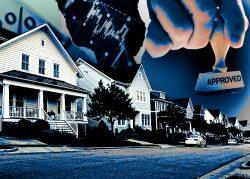To find the last time mortgage demand was this low, you’d have to put on your Y2K glasses.
For the week ending June 3, the Mortgage Bankers Association’s index measuring mortgage loan application volume dropped 6.5 percent from the week before, sinking to its lowest level in 22 years.
Driving the decline are increases in mortgage rates and home prices and a paucity of homes for sale. Rates have been rising all year, predating the Federal Reserve’s efforts to slow the economy, although the average 30-year fixed rate for conventional loans did edge down for three straight weeks before jumping 7 basis points to 5.40 percent last week.
The increased rates led to drops in the MBA’s refinancing and purchasing indices.
Read more



“While rates were still lower than they were four weeks ago, they remain high enough to still suppress refinance activity,” said Joel Kan, an MBA associate vice president, in a statement.
The refinance index dropped 6 percent from the previous week and is down 75 percent year-over-year. The purchase index, which tracks mortgage applications to buy homes, plunged 18 percent from the previous week and is 21 percent lower than a year ago.
“The purchase market has suffered from persistently low housing inventory and the jump in mortgage rates over the past months,” Kan said, noting the particular difficulties for first-time buyers.
Points rose to 0.51 from 0.60 (including origination fee) for loans with a 20 percent down payment.
The share of total applications through the FHA — reflecting buyers seeking to make a small down payment — increased from 10.8 percent to 11.3 percent from a week earlier, while the share of Veterans Administration applications also increased, from 10.2 percent to 11.4 percent. The USDA share of applications remained at 0.5 percent, or 1 out of every 200 loans.
While mortgage rates are still lower than they were before the pandemic, buyers are feeling some sticker shock after growing accustomed to rates in the neighborhood of 3 percent.
In the first week of this year, the average rate for a 30-year fixed-rate loan was 3.22 percent. In early 2021, it was 2.65 percent.
Rising mortgage rates and hefty price increases across the country have some wondering if this is the last call for the country’s housing boom.
